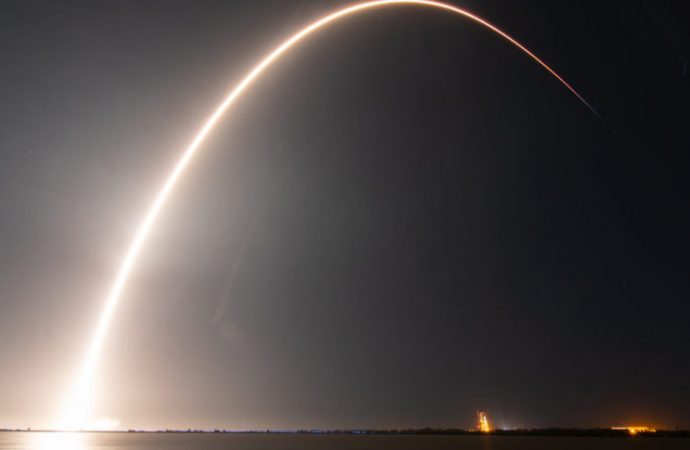A SpaceX Falcon 9 carrying an Indonesian communications satellite, an Israeli lunar lander and a U.S. Air Force smallsat launched Feb. 21 from Cape Canaveral, Florida.
The Falcon 9 lifted off at 8:45 p.m. Eastern, deploying the Beresheet lunar lander 33 minutes later, and the Nusantara Satu telecom satellite with the S5 experimental smallsat nearly 45 minutes after liftoff.
SpaceX landed the Falcon 9’s first-stage booster on the drone ship “Of Course I Still Love You” in the Atlantic Ocean. It was the third mission for the booster, which first flew in July with 10 Iridium Next communications satellites and again in October with a radar satellite for the Argentine space agency CONAE.
SpaceX described the booster recovery — its 34th — as facing “some of the most challenging reentry conditions to date.”
SpaceX founder Elon Musk tweeted after the landing that the booster survived the “Highest reentry heating to date.” Musk added that SpaceX will use the booster for a fourth time in April for the Crew Dragon in-flight abort test.
U.S. satellite manufacturer Space Systems Loral, a Maxar company, purchased the Falcon 9 launch on behalf of its customer Pasifik Satelit Nusantara, or PSN. While most Falcon 9 missions to geostationary transfer orbit carry just one satellite at a time, PSN sought co-passengers in order to lower the cost of launching its Nusantara Satu satellite, formerly known as PSN-6. Space Systems Loral took on that responsibility, signing up rideshare broker Spaceflight Inc. of Seattle, Washington, which then secured Israel’s 600-kilogram Beresheet lander and the Air Force Research laboratory’s 60-kilogram S5 smallsat.
The launch was SpaceX’s second of the year, following a January launch for satellite operator Iridium.
Israel headed to the moon
Israeli nonprofit SpaceIL’s Beresheet lander separated 33 minutes after liftoff. The lander, whose name is Hebrew for Genesis, began a two month journey to the moon using its own propulsion.
SpaceIL was originally building the Beresheet lander for the Google Lunar X Prize, but continued on with the lander after the contest ended in March 2018 without a winner for the $20 million award.
Beresheet stands to make Israel the fourth country to land on the moon, following the United States, Russia and China. It will also be the first non-governmental spacecraft to attempt a lunar landing.
SpaceIL’s mission for the lander is to beam back photos and video, and to measure the magnetosphere. The lander will use a thruster from Norwegian supplier Nammo to reach the moon, and to conduct a 500-meter “hop” to another location on the lunar surface. SpaceIL will attempt the lunar landing April 11.
Israel’s state-owned satellite manufacturer Israel Aerospace Industries built the Beresheet lander. The company, inspired by SpaceIL’s lunar ambitions, has developed commercial ambitions of its own regarding the moon. Last month Israel Aerospace Industries partnered with German spacecraft builder OHB to offer a version of the lander it built for SpaceIL to the European Space Agency for commercial delivery of payloads to the moon’s surface.
PSN connecting Indonesia
Nusantara Satu is a 4,100-kilogram communications satellite equipped with C- and Ku-band transponders, mainly for broadband connectivity. The satellite’s name translates to “One Archipelago,” referencing PSN’s home country and primary market of Indonesia, which consists of more than 17,000 islands. SSL built the satellite with chemical and electrical propulsion.
In an interview this week, PSN CEO Adi Rahman Adiwoso said the operator has been leasing capacity on roughly half a dozen other spacecraft and borrowing AsiaSat-3S, a nearly 20-year-old satellite from Hong Kong-based AsiaSat, to provide communications services across the Indonesia.
Adiwoso said 70 to 75 percent of Nusantara Satu’s capacity is already spoken for, half of it for the Indonesian government and roughly a quarter for other customers, many of which PSN will transfer off of other operator’s spacecraft. He said PSN anticipates using Nusantara Satu to connect around 5 million people through Wi-Fi hotspots by the end of this year.
Air Force experiment gets going
The Air Force Research Laboratory’s S5 satellite will travel with the Nusantara Satu satellite close to geostationary orbit before deploying from the parent satellite. SSL is using an approach honed during a secret DARPA experiment last year that carried a smallsat into orbit aboard the geostationary communications satellite Hispasat-30W-6.
S5, built by Blue Canyon Technologies of Boulder, Colorado, is designed to study the space environment, evaluating if low-cost satellites can improve knowledge of objects in geostationary orbit 36,000 kilometers above the Earth.
Source: Space News

































Leave a Comment
You must be logged in to post a comment.